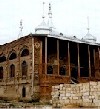 Mountain
Jews, or Juhuro, are Jews of the eastern Caucasus, mainly of Azerbaijan
and Dagestan. They are also known as East Caucasian Jews, or simply Caucasian
Jews. The name "Mountain Jews" or "Caucasian Jews" is something of a misnomer,
as it does not include Georgian and Ashkenazi Jews of the Caucasus Mountains.
Mountain
Jews, or Juhuro, are Jews of the eastern Caucasus, mainly of Azerbaijan
and Dagestan. They are also known as East Caucasian Jews, or simply Caucasian
Jews. The name "Mountain Jews" or "Caucasian Jews" is something of a misnomer,
as it does not include Georgian and Ashkenazi Jews of the Caucasus Mountains.
They call themselves "Juhuro" (or "Juwuro" in the Kuba dialect), which simply means "Jews" - any Jews, for example "Juhur Eshgenezini" - Ashkenazic Jew, while "Juhur imuni" means "our Jew", i.e. East-Caucasian Jew. They also call themselves "'ivri" and "yehudi," especially older people.
In literature they have been referred to as East Caucasian Jews, Mountain Jews, Jewish Tats, Juhur, and Dagh Chufut. In Russian, they are known as Gorskiye Yevrei, meaning "Mountain Jews."
Location
The majority of Caucasian Mountain Jews
live in Azerbaijan and Dagestan. In Azerbaijan their main settlements are
Krasnaya Sloboda (part of Quba, Vartashen),
and some other towns. In Dagestan they mostly live in Kaitag, and Magaramkend
(three settlements), Derbent, and Makhachkala.
A smaller number have settled in Northern Caucasus — Gorny and Nalchik.
In the period 1970–90 the majority of Mountain Jews emigrated to Israel,
and some moved to Russia, the US and th EU.
Population
Their population is difficult to estimate,
as during censes the Mountain Jews have been counted as members of the
overall Jewish community, or as Tats, who use
a similar language. In 1926 they numbered approximately 26,000; in 1959
about 15,000 lived in Dagestan (Russia total was 16,707) and more than
10,000 in Azerbaijan. In 1979 the overall number of Jews in Dagestan was
19,000 and 35,000 in Azerbaijan; the percentage of Mountain Jews is unknown.
Language
The Mountain Jews speak Juhuri, or Judeo-Tat, a dialect of Tat (SO 639-3: ttt) which is related to Middle Persian. It belongs to the Iranian division of the Indo-European languages.
Ethnic origins and history
In terms of ethnic origin, it is assumed that the Mountain Jews and Tats have inhabited Caucasia for a long time. Their distant forefathers once lived in southwest Persia, the south-western part of present-day Iran. It was there that they adopted the Middle Persian language. The predecessors of the Mountain Jews settled in Caucasian Albania in the 5th–6th century and from that time on their history has been related to the mountains and the people of Dagestan. Their tradition says that they lived in the eastern Caucasus since 722 BCE.
There are several theories about their origins. One is that they are descended from Jewish military colonists settled by Parthian and Sassanid rulers in the Caucasus as frontier guards against nomadic incursions from the Pontic steppe. Another speculation is that they are ethnic Tats converted to Judaism. Still others regard the Muslim Tats as Mountain Jews that converted to Islam. Another theory is that they are descended from the Khazars; however, this seems unlikely, since they appear to have been settled in the Caucasus prior to the rise of the Khazar polity. They may have been allied or subject to the Khazar Khaganate, and likely accepted Jewish Khazars into their communities following the fall of Khazaria in the 10th and 11th centuries CE.
The Mountain Jews resettled from the mountains to the coastal lowlands in the 18th–19th century, but carried the name "Mountain Jews" with them. In the villages (aouls) the Mountain Jews settled in a part of their own, in towns they did the same, although their dwellings did not differ from their neighbours’. The Mountain Jews also took to wearing the highlanders’ dress. Judaic prohibitions ensured they retained specific dishes, and their faith was still enshrined in the rules for family life.
While elsewhere in the Jewish diaspora it was forbidden to own and till land (cf. the Jews of Central Asia), at the end of the 19th and the beginning of the 20th century the Mountain Jews were farmers and gardeners, growing mainly grain. Their oldest occupation was rice-growing, but raising silkworms and tobacco was also popular. The Jewish vineyards were especially famous. The Jews and their Armenian neighbors were the main producers of wine, an activity banned for Muslims by religion. Judaism, in turn, limited meat consumption; and unlike their neighbors, they raised few domestic animals.
At the same time they were renowned tanners. Tanning was the third most important activity after farming and gardening, and at the end of the 19th century 6% of Jews were engaged in this trade. Handicrafts and commerce were mostly practiced by Jews in towns.
The Soviet authorities bound the Mountain Jews to collective farms, but allowed them to carry on in their traditional ways, growing grapes, tobacco, and vegetables and making wine. However, the former isolated lifestyle of the Jews has practically been eradicated, and they now live side by side with other ethnic groups.
Originally education was only for the boys, who attended synagogue schools. With Sovietization, Tat became the language of tuition at newly-founded elementary schools. It remained so till the beginning of World War II. The publication of the first native-language newspaper, Zakhmetkesh (Working People), began in 1928. After the war Russian became the only acceptable language at Dagestan schools, and the publication of the newspaper stopped. Currently Mountain Jewish intellectuals are active in Dagestani culture.
sources: wikipedia - GNU lic.